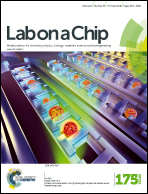Microfluidic technique for measuring wax appearance temperature of reservoir fluids
Abstract
A microfluidic technique for measuring wax appearance temperature (WAT) of reservoir fluids is presented. The technique is based on continuous monitoring of pressure across a microchannel as wax particles are deposited and gradually clog the channel. A rapid pressure increase was observed as the temperature was systematically decreased to wax appearance temperature. The relationship between pressure change rate and sample temperature is explored as the working principle in the proposed WAT measurement technique. This technique yields results which are comparable to measurements obtained from a cross-polar microscopy technique (CPM); the current industry-standard for WAT measurement. The method is validated by systematically investigating phase transition of pure hydrocarbons, binary mixtures, and real crude oils. The new technique has two distinct advantages over the existing industry standard methods in that its experimental setup is much simpler and it can be adapted to field applications. The microchannel can be easily cleaned and reused to test different samples.


 Please wait while we load your content...
Please wait while we load your content...